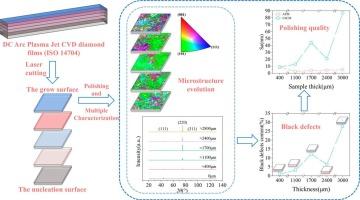Effect of microstructure evolution in ultra-thick diamonds on high-quality polishing
IF 5.1
3区 材料科学
Q2 MATERIALS SCIENCE, COATINGS & FILMS
引用次数: 0
Abstract
Ultra-thick diamond films (>3 mm) compliant with ISO 14704 were fabricated via Direct Current Arc Plasma Jet Chemical Vapor Deposition (DC Arc Plasma Jet CVD). Multiple characterization techniques, including X-ray Diffraction (XRD), Scanning Electron Microscope (SEM), Electron Back Scatter Diffraction (EBSD), Optical Microscope (OM), Laser Scanning Confocal Microscopy (LSCM) and Atomic Force Microscope (AFM), were employed to systematically investigate the correlations between microstructure evolution, black defects (growth pores), and polishing quality (surface roughness) on the growth surfaces of ultra-thick diamonds. As diamond film thickness increases, the preferred orientation transitions from {111} to {110} planes. This shift primarily results from twins-induced lattice stacking variations that induce orientation dispersion, coupled with the cooperative effects of twins-induced randomization (Σ3 twins >52 %) and Ostwald Ripening. Ostwald Ripening facilitates the consumption of disadvantageously oriented grains by {110}-oriented grains. Under the OM, the area of black defects (growth pores) first increases, then decreases, and subsequently increases again, peaking at thicknesses of 1700 μm and 3000 μm. This fluctuation in defect content is directly correlated with variations in polishing quality. Through crystallographic evolution and surface integrity analysis of DC Arc Plasma Jet CVD diamond films (>3 mm), this study establishes the correlation between microstructure gradients, pore distribution, and polishing quality. These findings provide a theoretical foundation for engineering applications of ultra-thick diamond.

超厚金刚石微观结构演变对高质量抛光的影响
采用直流电弧等离子体射流化学气相沉积(DC Arc Plasma Jet CVD)技术制备了符合ISO 14704标准的超厚金刚石膜(> 3mm)。采用x射线衍射(XRD)、扫描电镜(SEM)、电子背散射衍射(EBSD)、光学显微镜(OM)、激光扫描共聚焦显微镜(LSCM)和原子力显微镜(AFM)等多种表征技术,系统研究了超厚金刚石生长表面的微观结构演化、黑色缺陷(生长孔)和抛光质量(表面粗糙度)之间的关系。随着金刚石膜厚度的增加,优选取向从{111}面过渡到{110}面。这种转变主要是由双胞胎诱导的晶格堆叠变化引起的取向色散,再加上双胞胎诱导的随机化(Σ3 twins > 52%)和奥斯特瓦尔德成熟的合作效应。奥斯特瓦尔德催熟促进了{110}取向谷物对不利取向谷物的消费。在OM作用下,黑色缺陷(生长孔)的面积先增大后减小,在1700 μm和3000 μm厚度处达到峰值。缺陷含量的波动与抛光质量的变化直接相关。本研究通过对DC电弧等离子体射流CVD金刚石膜(> 3mm)的晶体学演化和表面完整性分析,建立了微观结构梯度、孔分布与抛光质量之间的相关性。这些研究结果为超厚金刚石的工程应用提供了理论基础。
本文章由计算机程序翻译,如有差异,请以英文原文为准。
求助全文
约1分钟内获得全文
求助全文
来源期刊

Diamond and Related Materials
工程技术-材料科学:综合
CiteScore
6.00
自引率
14.60%
发文量
702
审稿时长
2.1 months
期刊介绍:
DRM is a leading international journal that publishes new fundamental and applied research on all forms of diamond, the integration of diamond with other advanced materials and development of technologies exploiting diamond. The synthesis, characterization and processing of single crystal diamond, polycrystalline films, nanodiamond powders and heterostructures with other advanced materials are encouraged topics for technical and review articles. In addition to diamond, the journal publishes manuscripts on the synthesis, characterization and application of other related materials including diamond-like carbons, carbon nanotubes, graphene, and boron and carbon nitrides. Articles are sought on the chemical functionalization of diamond and related materials as well as their use in electrochemistry, energy storage and conversion, chemical and biological sensing, imaging, thermal management, photonic and quantum applications, electron emission and electronic devices.
The International Conference on Diamond and Carbon Materials has evolved into the largest and most well attended forum in the field of diamond, providing a forum to showcase the latest results in the science and technology of diamond and other carbon materials such as carbon nanotubes, graphene, and diamond-like carbon. Run annually in association with Diamond and Related Materials the conference provides junior and established researchers the opportunity to exchange the latest results ranging from fundamental physical and chemical concepts to applied research focusing on the next generation carbon-based devices.
 求助内容:
求助内容: 应助结果提醒方式:
应助结果提醒方式:


